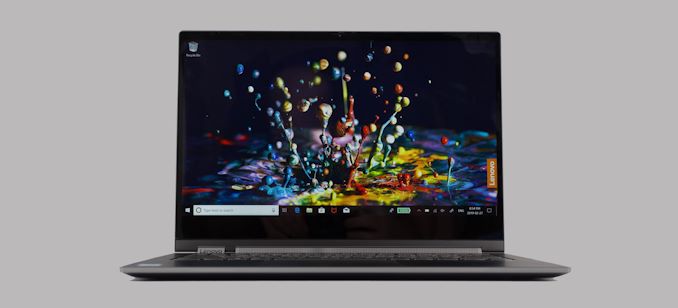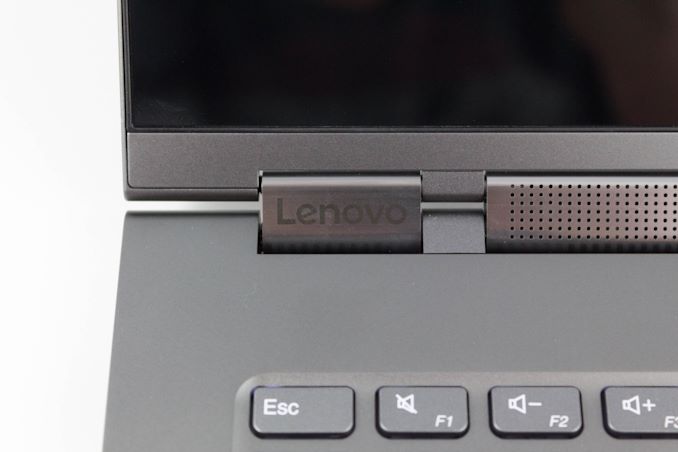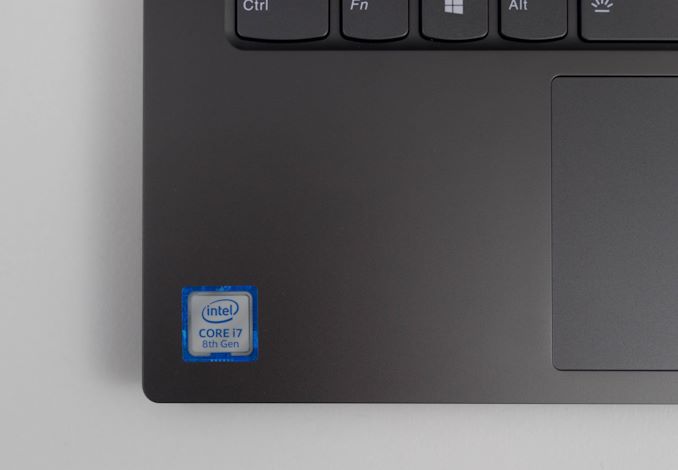The Lenovo Yoga C930 Review: Atmos Acoustics
by Brett Howse on March 1, 2019 8:00 AM EST
Back when laptops were just finding their way into the new world of touch, Lenovo’s Yoga design ended up inspiring the industry, and Lenovo has moved their 360° hinge across their lineup, from laptops starting at $199.99, all the way to their ThinkPad lineup with the X1 Yoga. Today we are taking a look at the Lenovo Yoga C930 which was announced a few months ago. This is Lenovo’s premium offering for Yoga in their consumer lineup, and brings some new innovations to the game that will once again make the industry play catch-up.
Lenovo has some very interesting ideas that are packed into this convertible notebook. The biggest change is the removal of the beautiful watchband hinge we’d admired on previous generations, but although it was beautiful and functional, Lenovo has instead opted to replace it with a Dolby Atomos sound bar, which can rotate with the display to provide 3D spatial sound no matter which way the display is pointing. Audio on Yoga-style laptops has been kind of a mixed bag. For one thing, there’s very little room inside a modern laptop to provide space for speakers to start with, and for another, they tend to fire in the wrong direction, which is an issue that convertibles like the Yoga have to deal with more than typical laptops. The rotating sound bar not only provides space that would otherwise be unused, but it also keeps the speakers pointed in a consistent direction to the user. Much like the original Yoga hinge, expect other OEMs to imitate this idea soon, because it is really a smart solution.
The rest of the Yoga C930 is no slouch either. This isn’t a one-trick pony. It’s also a premium Ultrabook, offering a great design coupled with powerful internals, all in a package that is thin, and weighs just 1.36 kg / 3.0 lbs. It also offers thin display bezels on the sides, allowing this 14-inch laptop to still be fairly compact, and the top bezel is just large enough to house the Webcam, which also has a manual shutter. Display options are 1920x1080 IPS, or 3840x2160 IPS.
Lenovo outfits the Yoga C930 with Kaby Lake Refresh processors, in either the Core i5-8250U, or the Core i7-8550U. Our review unit is the Core i7. Memory options are 8, 12, or 16 GB of DDR4-2400, which is somewhat unusual in an Ultrabook form factor, since most manufactures opt for LPDDR3 still. With Lenovo opting for DDR4, it’s a bit strange they haven’t used that as an opportunity to provide 32 GB of RAM as an option. Where they do provide plenty of options though is the NVMe storage, where you can get up to 2 TB of PCIe NAND.
| Lenovo Yoga C930 | |||||
| Reviewed: Core i7-8550U 12GB RAM 256 GB SSD 1920x1080 | |||||
| CPU | Core i5-8250U 4C/8T 1.6-3.4 GHz 6MB Cache 15W TDP Core i7-8550U 4C/8T 1.8-4.0 GHz 8MB Cache 15W TDP |
||||
| GPU | Intel UHD 620 | ||||
| RAM | 8 / 12 / 16 GB DDR4-2400 | ||||
| Storage | 256 GB to 2 TB PCIe NVMe SSD | ||||
| Display | 13.9" 1920x1080 IPS Multi-Touch with Dolby Vision 13.9" 3840x2160 IPS Multi-Touch with Dolby Vision |
||||
| Battery | 60 Wh 65W AC Adapter |
||||
| Network | Intel Wireless-AC 9260 2x2:2 802.11ac 160 MHz channels Bluetooth 4.1 |
||||
| I/O | 2 x USB-C Thunderbolt 3 1 x USB 3.0 Headset jack |
||||
| Dimensions | 322 x 227 x 14.5 mm 12.7 x 8.9 x 0.57 inches |
||||
| Weight | 1.36 Kg / 3.0 lbs | ||||
| Extras | Wacom AES Active Pen (Included) Fingerprint Reader Dolby Atmos Sound Bar Webcam Shutter |
||||
| Price | Starting at $1069.99 Price as tested: $1270 |
||||
Lenovo offers not one but two Thunderbolt 3 ports over Type-C on the left side, along with a USB 3.0 port as well. The Type-C is used not only for expansion, but also as the charging port, which makes the Lenovo very easy to power up from a variety of sources.
Lenovo also offers an active pen, which is housed inside the laptop, and can be accessed on the rear of the device. It’s great for quick note taking, and having it inside the laptop protects it, charges it, and makes sure it’s always available.
In addition, Lenovo offers a good-sized battery at 60 Wh, in addition to the Intel Wireless-AC 9260 wireless card.












32 Comments
View All Comments
HStewart - Friday, March 1, 2019 - link
But Intel completion is upper end of laptops is really subpar in performance level. They might want to believe they compete on that level but manufactures understand this and they are not going waste there time - on a product that fans want in mobile industry but they don't buy mobile but instead purchase desktops. There are of course exceptionCHUWI - in my experience with them they are trying to implied that they have high end competitor but actually use the lower end chips. To me this is misleading the customer - to have a Surface Pro looking device with a lower end performance.
Windows for ARM tablets - this is strange part of mobile industry, I personally think a better fit would Chromebooks where native x86 performance is likely not required - but to fool a customer to think they have a full speed notebook to run existing apps is insane. I think they do have limited uses if only web browsing, and Microsoft office applications required. They do have good battery life but the latest generation of notebooks come very close and with Intel Lakefield on the horizon, I believe battery advantage will be gone. But there is not much on this but I believe a combination of 4 low power efficient cores combine with Sunny Cove performance core combine with Gen 11 graphics core - with close to discrete level performance in size of chip that can fit on tip of your finger is going to be quite awesome. This is likely going to remind of days when Intel went from Core 2 to i7 technology.
I loved the EMiB technology and with Lakefield they take it step farther with Foveres technology is going being better. Just image a notebook with more IO on one level, power mult-core logic on next level and high performance discrete GPU on next level. With this technology they could package 100 if not 1000's of cores on desktop size chip.
ChickenLegsxx - Thursday, June 20, 2019 - link
Download Popcorn Time for android from this page https://getpopcorntimeapk.comUpSpin - Friday, March 1, 2019 - link
It the Pen WACOM AES, or N-Trig or Synaptics or ....How does the pen get charged? Inductive in the storage slot? Are you sure? Maybe it's Wacom EMR, as in the Wacom Intuos series/Samsung Galaxy tablets/Samsung Note smartphones, then there's no need to charge the pen at all, because it's coupled inductively with the display.
How good is the accuracy of the pen? Can you draw straight lines or do they wobble?
How is the pressure sensitivity of the pen? How many levels, how sensitive?
Does the pen have an eraser on the back? Does the pen have some buttons? Does the peen offer some other functionality.
How does the pen feel on the display? Is the surface good to write on?
How does the pen perform on the edges of the display?
Please, it's a tablet you can write on, why don't you include this in your review. Just because the delivered pen is small doesn't mean the you can't buy a better larger one afterwards, as long as you know which one. Maybe the HP Active Styli work, or do we need N-Trig?
Brett Howse - Friday, March 1, 2019 - link
It's Wacom AES and feels good on the display and works well. It's not a top-tier stylus but for writing it's great.Thud2 - Friday, March 1, 2019 - link
Are you practicing your typing skills. 300 words to say "What about the pen?"heffeque - Saturday, March 2, 2019 - link
Laughed harder than I should have.Prestissimo - Friday, March 1, 2019 - link
Wacom AES 2.0 technology, 4096 pressure levels, official name is Lenovo Active Pen 2.For compatibility with both Wacom AES and N-Trig / MPP, get the Bamboo Ink Pen which is currently regarded as the best 2-in-1 laptop stylus you can buy.
imaheadcase - Saturday, March 2, 2019 - link
Because most our touch screen and no one uses a pen is why. loleastcoast_pete - Friday, March 1, 2019 - link
@Brett: Thanks for this review. Question: In addition to the soundbar, what kind of audio chipset does this Yoga use? Dolby Atmos usually implies 7+1 or more channels to get the Atmos surround effects. I don't expect that from the built-in speakers, of course, but can this thing provide 7+1 or 9+1 output to amplifiers to really get Atmos surround sound? To member the Atmos branding implies that. Thanks!Brett Howse - Friday, March 1, 2019 - link
Dolby Atmos on PC doesn't require or imply 7+1. Even in the HT world you can get Atmos sound bars. Will it be as immersive as a 7 channel setup with true height speakers? No of course not. But it still provides a wider sound stage from the included speakers in this sound bar.You can get more info from Dolby's website.
The laptop has an Intel audio chipset (SST) and Realtek codec. As for outputting to a receiver, there's no specific digital audio output like HDMI to carry the signal. You'd have to go over the USB/TB3 connections.